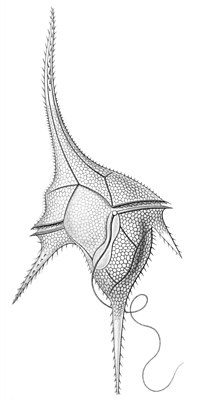
Photo from wikipedia
These results indicate that sterol metabolites in Symbiodiniaceae are clade specific, that their biosynthetic pathways share architectural and substrate specificity features with those of animals and plants, and that environmental… Click to show full abstract
These results indicate that sterol metabolites in Symbiodiniaceae are clade specific, that their biosynthetic pathways share architectural and substrate specificity features with those of animals and plants, and that environmental stress-specific perturbation of sterol biosynthesis in dinoflagellates can impair a key mutualistic partnership for healthy reefs. ABSTRACT Cnidarians cannot synthesize sterols (which play essential roles in growth and development) de novo but often use sterols acquired from endosymbiotic dinoflagellates. While sterol availability can impact the mutualistic interaction between coral host and algal symbiont, the biosynthetic pathways (in the dinoflagellate endosymbionts) and functional roles of sterols in these symbioses are poorly understood. In this study, we found that itraconazole, which perturbs sterol metabolism by inhibiting the sterol 14-demethylase CYP51 in dinoflagellates, induces bleaching of the anemone Heteractis crispa and that bleaching perturbs sterol metabolism of the dinoflagellate. While Symbiodiniaceae have clade-specific sterol metabolites, they share features of the common sterol biosynthetic pathway but with distinct architecture and substrate specificity features of participating enzymes. Tracking sterol profiles and transcripts of enzymes involved in sterol biosynthesis across time in response to different environmental cues revealed similarities and idiosyncratic features of sterol synthesis in the endosymbiont Breviolum minutum. Exposure of algal cultures to high levels of light, heat, and acidification led to alterations in sterol synthesis, including blocks through downregulation of squalene synthase transcript levels accompanied by marked growth reductions. IMPORTANCE These results indicate that sterol metabolites in Symbiodiniaceae are clade specific, that their biosynthetic pathways share architectural and substrate specificity features with those of animals and plants, and that environmental stress-specific perturbation of sterol biosynthesis in dinoflagellates can impair a key mutualistic partnership for healthy reefs.
Journal Title: mSystems
Year Published: 2020
Link to full text (if available)
Share on Social Media: Sign Up to like & get
recommendations!